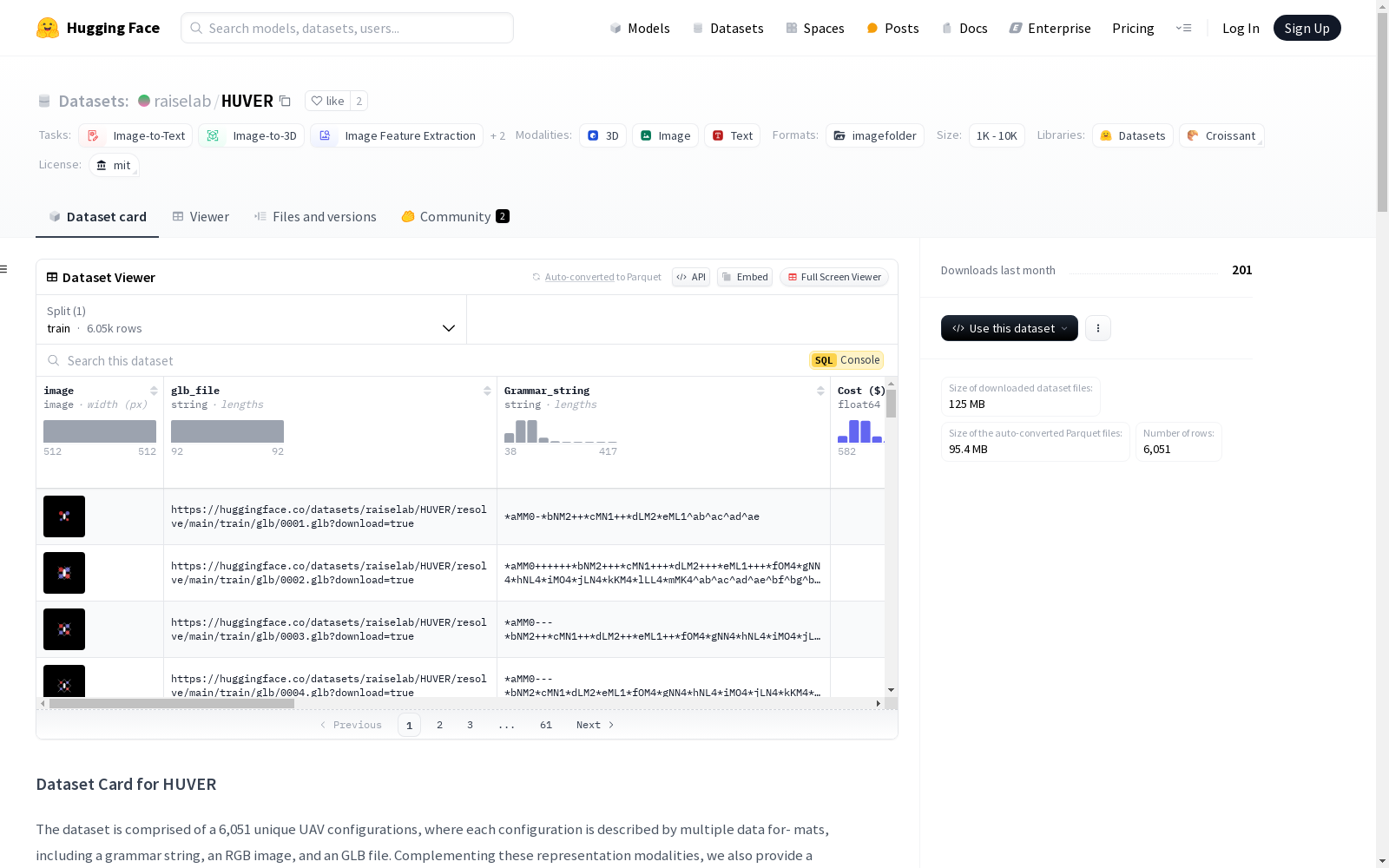HUVER|无人机数据集|多模态数据数据集
收藏数据集卡片 for HUVER
概述
HUVER数据集包含6,051个独特的无人机配置,每个配置通过多种数据格式描述,包括语法字符串、RGB图像和GLB文件。此外,还提供了基于配置的描述,即使用自然语言描述每个无人机的特征。
语言
- 语言(NLP): 英语, en
许可证
- 许可证: MIT
用途
直接用途
- 该多模态无人机数据集包含多种无人机表示形式,如GLB格式的3D模型、语法表示、文本描述和参数数据。这种多样性有助于开发利用不同无人机表示形式的代理模型,以更准确地预测性能。
- 该多方面无人机数据集支持通过各种生成模型创建多样化的无人机设计。模型如GANs、LSTMs、transformers和GNNs可以生成新的无人机图像和不同格式的设计,包括GLB。数据集中包含的负面示例有助于早期识别和纠正潜在的设计缺陷,增强模型细化和确保无人机设计的可行性和安全性。
超出范围的用途
- 该数据集不适用于飞行准备系统的详细设计。
数据集结构
数据实例
json { Image: <0001.png>, glb_file: https://huggingface.co/datasets/raiselab/HUVER/resolve/main/train/glb/0001.glb?download=true, Grammar_string": <*aMM0-*bNM2++*cMN1++dLM2eML1^ab^ac^ad^ae>, Cost ($): <1877.19>, Number of Batteries: <1>, Number of Motor-Rotor Pairs: <4>, Number of Airfoils: <0>, Number of Connectors: <4>, Weight of Batteries (lb): <19.40347644>, Weight of Motor-Rotor Pair (lb): <3.858051314>, Weight of Airfoils (lb): <0.0>, Total Weight (lb): <23.26152854>, Total Thrust (lb): <82.50002518>, Normalized Average Structure Size: <0.324324324>, Normalized Average Motor Size: <0.259259259>, Normalized Average Foil Size: <0.0>, Design Descriptor: <This drone is made up of 1 part and has 4 engines that help it move. It also has 0 wings for better flying. It has 4 links that connect everything together securely. The drone weighs 23.2615285432816 pounds in total and can lift itself and more, thanks to its strong thrust of 82.500025177002 pounds.>, Operations Descriptor: <This drone configuration has a feasible flying range of 0.0-0.0 miles, evaluated over the payload range of 0-0 pounds. This configuration has a velocity range of 0.06352621-0.06352621 mph. It is observed when payload increases, the flying range and velocity decrease. The drones achieve highest values of velocity and range for the lowest payloads. It can be interpreted from the data that the drone can fly as far as 0.0 miles, and can reach maximum speeds up to 0.06352621 mph. This means that while the drone does well in many situations, how far and fast it can fly can vary with how much payload it carries. This drone costs around $1877.19, adding up costs of all the components used to achieve this configuration.>, Performance: <Feasibilty": "CouldNotStabilize", "Flying Range": 0.0, "Payload Capacity (lb)": 0, "Velocity (mph)": 0.06352621, "Performance Descriptor": "This drone could not hover. The drone for a payload of 0 pounds, could not accomplish a successful run, the reason being either the motors could not provide enough lift or the drone did not balance properly after flight".> }
数据字段
- Grammar String: 每个无人机配置可以通过一个语法字符串完全描述,该字符串根据特定的预定义语法规则结构化。
- Image: 对应于无人机配置(语法字符串)的RGB图像的俯视图。
- glb: 对应无人机配置的详细空间结构的3D网格表示。
- 配置参数字段: 包括电池数量、电机-旋翼对数量、翼片数量、连接器数量、电池重量、电机-旋翼对重量、翼片重量、总重量、总推力、归一化平均结构尺寸、归一化平均电机尺寸、归一化平均翼片尺寸。
- 文本描述:
- Design Descriptor: 基于无人机配置的设计描述。
- Performance Descriptor: 基于无人机模拟结果的性能描述。
- Operational Descriptor: 基于无人机操作范围的性能曲线描述。

My Sexy Neighbor 🔞 Prologue Review Stats and Historical Trends
The My Sexy Neighbor 🔞 Prologue Steam review dataset lets you explore review stats, trends, and history for My Sexy Neighbor 🔞 Prologue reviews on Steam. Data is aggregated month over month going back to November 2024.
steambase.io 收录
中国区域交通网络数据集
该数据集包含中国各区域的交通网络信息,包括道路、铁路、航空和水路等多种交通方式的网络结构和连接关系。数据集详细记录了各交通节点的位置、交通线路的类型、长度、容量以及相关的交通流量信息。
data.stats.gov.cn 收录
China Health and Nutrition Survey (CHNS)
China Health and Nutrition Survey(CHNS)是一项由美国北卡罗来纳大学人口中心与中国疾病预防控制中心营养与健康所合作开展的长期开放性队列研究项目,旨在评估国家和地方政府的健康、营养与家庭计划政策对人群健康和营养状况的影响,以及社会经济转型对居民健康行为和健康结果的作用。该调查覆盖中国15个省份和直辖市的约7200户家庭、超过30000名个体,采用多阶段随机抽样方法,收集了家庭、个体以及社区层面的详细数据,包括饮食、健康、经济和社会因素等信息。自2011年起,CHNS不断扩展,新增多个城市和省份,并持续完善纵向数据链接,为研究中国社会经济变化与健康营养的动态关系提供了重要的数据支持。
www.cpc.unc.edu 收录
PASCAL VOC 2007
这个挑战的目标是从现实场景中的许多视觉对象类别中识别对象(即不是预先分割的对象)。它基本上是一个监督学习问题,因为它提供了一组标记图像的训练集。已选择的 20 个对象类别是: 人:人 动物:鸟、猫、牛、狗、马、羊 交通工具:飞机、自行车、船、公共汽车、汽车、摩托车、火车 室内:瓶子、椅子、餐桌、盆栽、沙发、电视/显示器 将有两个主要比赛和两个较小规模的“品酒师”比赛。内容:提供的训练数据由一组图像组成;每个图像都有一个注释文件,为图像中存在的 20 个类别之一中的每个对象提供一个边界框和对象类别标签。请注意,来自多个类的多个对象可能出现在同一图像中。
OpenDataLab 收录
遵义市2024年市本级一般公共预算收入预算表(草案)
遵义市2024年市本级一般公共预算收入预算表(草案)
贵州省政府数据开放平台 收录
